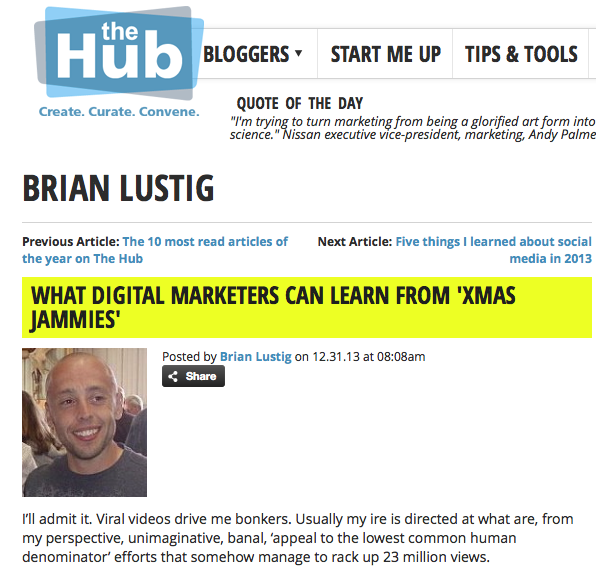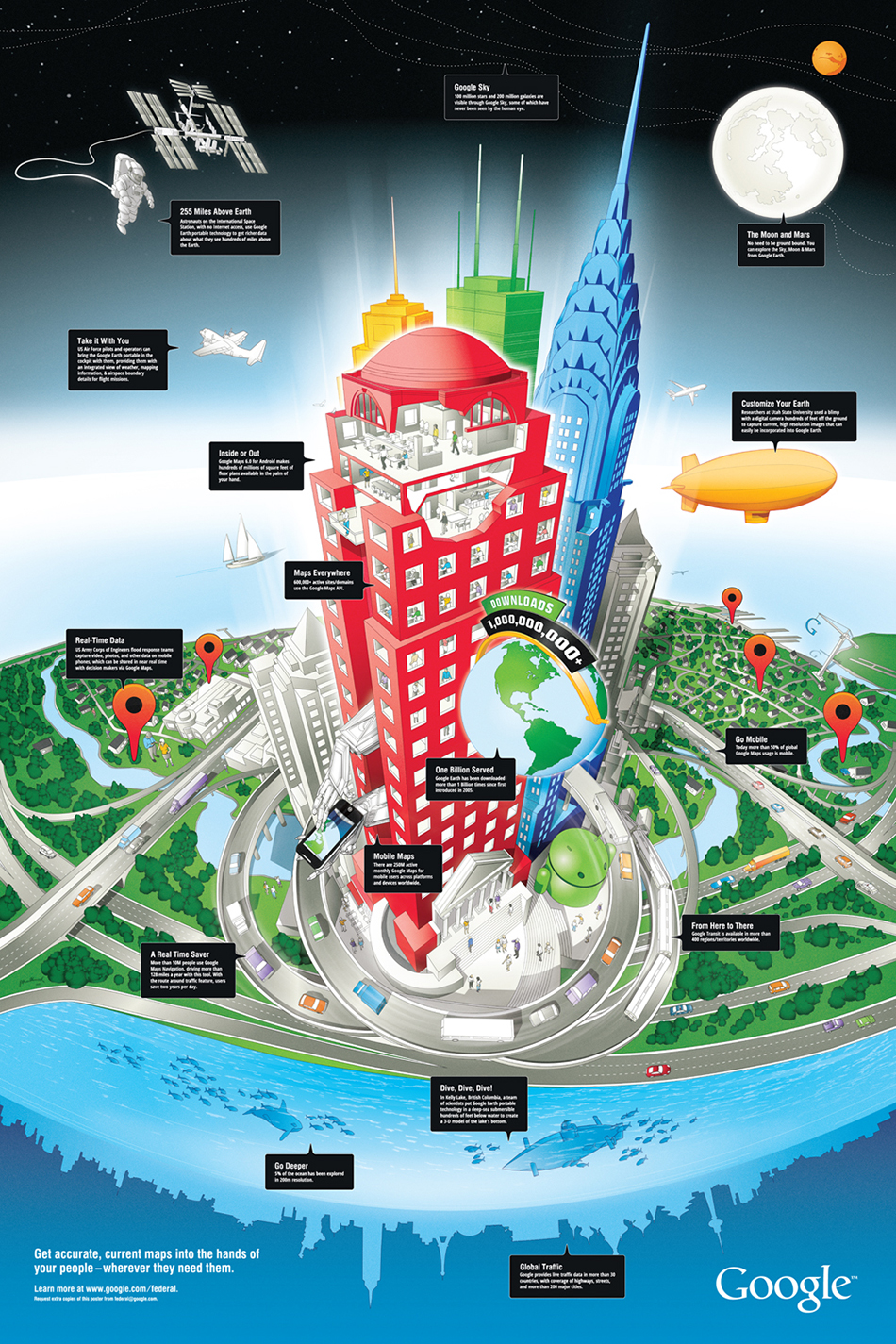The federal, state and local government markets are large and attractive targets of opportunity for technology companies. Because of our location and experience in the public sector supporting the most recognized brands in global technology, Bluetext is frequently asked to develop innovative marketing campaigns to help companies throughout Silicon Valley drive visibility for their brand and demand for their products and services across the public sector market. This can range from a dedicated microsite to traditional public relations and everything in between – including content marketing, social media and, of course, advertising – all integrated to help our clients succeed in an increasingly digital environment.
The challenge for companies seeking to expand from the commercial sector to government market is that agencies speak a different language, have an entirely unique buying cycle and process, and are motivated by different needs and priorities than private sector enterprise companies. For those who don’t recognize this and fail to develop their campaigns with that in mind, their efforts will feel as if they fell on deaf ears when the reality is that you are just speaking the wrong language. Here are some of the rules to keep in mind for the public sector audiences:
1) Think mission goals over ROI. Agencies are driven by legislative mandates and regulatory requirements, and that’s how officials get promoted and move up the chain.
2) Budget savings are important, but don’t talk about how your solution can reduce headcount. No one wants to put their jobs at risk. Talk about how agencies can cut costs and reallocate resources to where they are needed most.
3) Dedicated Government messaging that is clear and easy to find is essential. Agency decision-makers will not sort through corporate messaging to discern what might be important to them. If they can’t find it quickly, they will stop looking.
4) Easy-to-find government specific landing pages are a must. If decision makers don’t quickly find information that is directly relevant to them, they will move on to a competitor’s website. We all too often find government subpages buried deep into a site, and masked with an all too obvious government façade that will only serve to completely negate the hard work of your sales and field marketing teams dedicated to this market.
5) Social media should not be an afterthought in terms of dedicated content. We always recommend government-specific social media handles. Decision makers won’t sort through a dozen tweets about issues unrelated to the government to find the one that is. It is better to have low volume but a dedicated channel.
6) Customer case studies are important. No government official wants to be the beta tester of a new solution. They want to know how it’s been successfully used by other agencies – and there is no better way to tell that story than through the lens of their peers.
7) Highlight your government success stories. Government officials don’t get much recognition for a job well done, and they have strict rules about promoting themselves. But that doesn’t mean that you can’t tell their story, making them look good in the process.
8) The government audience cuts across all demographics. Personas are hard to create because they can be so different in age, how they get their information, what they read and their comfort level with new technologies. While the existing demos trend to the older side and rely on trade publications, agencies are aggressively recruiting in the younger demos who digest most of their content through social media. There is no ‘one-size-fits-all.”
9) Get involved in the community. If you are just getting started and don’t have case studies, getting involved in the community is important. Carpet baggers don’t succeed selling to the Federal government. It takes a dedicated, focused effort and commitment to the community.
10) It is not just Washington. Federal procurement teams and decision-makers are across the country – from U.S Central Command at MacDill AFB in Florida to San Diego to military bases in between, customers are everywhere and need to be messaged to appropriately. Knowing where the influencers are is often half the battle.
11) And a free bonus for listening – while so many brands are focused on the government buyer themselves – they ignore the contracting community around them. The mammoth defense contractors and systems integrators that surround the beltway can walk you down the red carpet into every agency in Washington – if only you spoke their language…
The Bluetext team has been working with Adobe and its public sector marketing and communications efforts for 15 years. One of the more fun events that we help support is the annual Adobe Digital Government Assembly (ADGA), an all-day gathering of government IT and marketing executives held here in Washington.
It’s been an especially long and brutal winter this year in Washington, so Bluetext wanted to do something different to help drive interest in this year’s ADGA. So we commandeered an ice cream truck, wrapped it in Adobe messaging around ADGA, loaded it up with hot chocolate, and spent three days driving around government office buildings here in the Nation’s Capital. Adobe wanted to both thank government workers for all their hard work, and attract attention to its annual gathering.
Bluetext leveraged social media to let agencies know when we would be coming by their buildings, and promoted the hot chocolate truck heavily in the days beforehand. The outreach was so successful that several reporters noticed the Twitter traffic and filed their own articles on the Adobe truck. On the day of ADGA, we parked the truck in front of the hotel venue starting at 7:30 in the morning, welcoming the attendees to the event.
Prior to the event, we also used social media to set hashtags and topics for ADGA so that those attending could participate in some of the immediate feedback. During the event, we live-Tweeted the highlights of the various speakers, and helped drive engagement. As a result, we had dozens of twitter-followers engaging in a real-time conversation about the presentations and discussions. Traffic was high enough to be a trending topic during the morning sessions!
Bluetext also reached out aggressively to traditional media and government trade publications to ensure that they would write about the trends and new technologies being applied to government missions. Those efforts paid off with coverage in Federal Computer Week and other news outlets.
Bluetext’s efforts supporting Adobe’s annual gathering shows how digital, traditional and guerrilla activities can all play together to drive awareness, attendance and coverage, while offering a fun way to thank customers for their work.
It certainly feels as if a traditional approach to media relations is on a downward slide to oblivion. With so many ways to connect directly with prospects, customers, and influencers, many companies are questioning the investment in old-school earned media. Even social media-based PR has become pervasive enough to feel ‘traditional’ to some degree. And with sponsored content, native advertising and pay-for-play by-lines gaining in popularity, it’s understandable that many marketers are becoming more deliberate in figuring out how to best structure a long-term public relations campaign. But as we like to tell our clients, while digital strategies are an essential part of the marketing mix, traditional media outreach is still important. Here are five common myths about public relations in the year 2014 that are worth examining:
1) Traditional PR is becoming irrelevant. This is a very tempting myth to buy into because fewer publications are thriving; and because fewer reporters are employed by those publications, it calls into question readership and impact. We continue to see layoffs across the media landscape, and some trade pubs have closed their doors. Print readership is way down, but many of these publications have maintained or upped their commitment to digital content. All of this is not necessarily an indictment of earned media as much as it is the “printed form” of earned media, which we still feel provides tangible validation of a company’s products or services, and enables thought leaders to shape conversations. An independent analysis from a credible publication will always be taken more seriously than your own marketing. In addition, the search engines continue to value original “good” content from news outlets over sponsored articles.
2) Sponsored content is just as good as earned media. It is true that target audiences are looking for good content, regardless of where it is published and by whom. Still, editors are struggling to incorporate sponsored content into their online publications. They know it’s a nice revenue stream, but they are still hesitant to do anything that might confuse their readers by making native advertising look too much like their own writing. As a result, it often is marked with their own version of a scarlet A—clearly denoting it as a paid placement.
3) Get a good article placed, and everyone will see it. It wasn’t that long ago that a print publication would get passed around an office so that actual readership might be many times the circulation. Those days are long gone, and many trade pubs have shifted to online only. That means that the likelihood that an individual print article will be seen and viewed by the right audience is falling. Instead, today’s media currency is sharing through social channels as well as direct outreach. We tell our clients to aggressively market their earned media placements as much as possible, and every good PR program needs to have a solid social media strategy. That increases the chance that prospects see the article as you can’t just assume that the target audiences you want to see the content will stumble across it organically. In addition, the search engines and social media algorithms put a premium on those that get shared the most, guaranteeing that the article will come up high in search results and in social feeds.
4) You can’t connect media coverage with leads and sales. Marketing and sales teams struggle to show a direct connection between media coverage and new sales leads. At Bluetext, we think that you can make that connection and show the value of media outreach, and that any smart PR program will have those types of metrics integrated into their campaigns based on tying media coverage to business objectives. There are effective methods to drive readers to landing pages and microsites, where re-targeting and other lead generation connections can be made and measured. The key is being smart about the tools you use and the results you are looking for.
5) Traditional PR is slowly but surely going the way of the dinosaurs. This myth is probably closest to some version of reality, depending on how one defines ‘traditional.’ As I said earlier, print as a PR medium is declining, but there are still news sources for which media coverage can have impact. At the end of the day, good content is good content, no matter where it is published. Getting that good content to the right audiences means using all of the platforms—traditional and digital. No one can afford to put all of their eggs in one basket anymore. Campaigns must be integrated and coordinated for maximum impact.
With so much value and change coming out of organic Search Engine Optimization it is easy to make a mistake. We’ve made a presentation of the top 10 mistakes you should try to avoid when working on your SEO campaigns.
From the second we wake up until the moment we fall asleep – our time and attention is dispersed across multiple screens, devices and media channels – this mass audience attention deficit disorder is further exacerbated by the fact that our primary screen of interest seems to change by the minute.
Lee Rainie of the Pew Internet and American Life Project summed up this phenomenon best, calling it “a constant state of partial attention”. So for marketers – this begs the question: How are you going to get my attention – and more importantly – get me to take action?
Roy H. Williams, author and lifelong student of humanity, wrote in his “Wizard of Ads” Trilogy that marketers typically assume that their audience is seeing and hearing their ads – yet rarely is this the truth. In reality the sheer volume of advertising that gushes toward the mind is like a fire hose aimed at a teacup – there simply too much coming at us to contain. Most of the information aimed at our brains is deflected, spilled or lost. And at the end of the day, precious little is actually retained.
As technology continues to drive how we communicate – it is also forcing marketers to innovate and embrace the powerful role that technology can play in driving demand above the funnel through brand engagement – or get crushed by their peers who have already adapted their strategies to stay one step ahead of an audience dispersed across an increasingly digital media landscape.
Roy Williams quipped that your audience will only ultimately recall an experience it was actively engaged in. So for your marketing to be truly effective, the audience must be a participant in it. The one tool Roy didn’t have access to when he wrote those words was digital marketing – for now anyway, and with the right agency partner – the easy button for today’s marketer to catch and actively engage his or her audience as they move ever so swiftly through their multi-screen lives.
We love pushing the envelope with our clients who understand the only way to stay visible – and relevant – is to continue to engage their audience in bold and innovative ways that gets them to stop and pay attention to their message. I have embedded a few examples of that which I am hopeful will get you to do the same.
By now, you may be one of the more than 13 million YouTube visitors who have viewed the clever, genuine yet very purposeful Xmas Jammies video, or saw it on any number of major broadcast outlets that picked it up. For marketing, creative, and PR professionals, viral videos can be maddeningly elusive. There are some characteristics universal to viral videos, but just as many that fall In the excerpt above, he discusses the technical problems with the federal health anthem insurance marketplace website and what his administration is doing to help consumers get enrolled in an anthem insurance plan. outside the blueprint as well.
In my latest article for PR Week “The Hub,” I take a look at some reasons why Xmas Jammies took off, and what digital marketers can learn from its success.




from Jason Siegel
On November 7th, the IRS Design Office hosted the second Design in Government (DIG) meeting in the main IRS Auditorium, the only meeting gathering of federal graphic designers government-wide. The goal of the DIG meeting was to strengthen the federal graphic design community and to help build relationships across federal agencies to encourage networking and discuss innovation, design management and design complex issues in a collaborative way, during these difficult budget times. Partner Jason Siegel presented the following presentation with supporting videos.

Everywhere you turn, people are talking about responsive design. It is a critical website solution for providing your customers and prospects a seamless experience across all devices and making it easy for you to manage one web infrastructure.
With a responsive website, businesses can be in front of consumers at every step of their online journey. A user viewing a website on the go via a mobile device can have the same powerful experience as when sitting in their office.
Responsive websites provide continuity between different viewing contexts, remaining completely agnostic to the type of device used and the size of the screen it has.
Unfortunately, a mobile version of your website isn’t good enough anymore. Responsive websites simplify internet marketing and SEO. Instead of having to develop and manage content for multiple websites, businesses with responsive sites can take a unified approach to content management because they have only the one responsive site to manage. The same applies to analytics and strategy development and deployment. A responsive website means there is only one set of analytics to examine and a single strategy to develop and deploy.
Responsive websites are easier for consumers to find than traditional or mobile sites because they come up higher in search engines’ rankings. Google recommends responsive web design because having a single URL for desktop and mobile sites makes it easier for Google to discover content and for Google’s algorithms, which are constantly changing, to assign indexing properties to content.
Responsive Design in the Future
Responsive design is still in its infancy, and the future looks extremely bright. All of our websites are responsive today, and our developers are exploring emerging areas of responsive design by testing a multitude of integrations that are now available.
As the internet transforms further into a platform of services and user interfaces that tie those services together, leveraging responsive design principals will allow companies to integrate a plethora of back-end services, such as Facebook, Twitter, Salesforce.com and Amazon Web Services, and then present the integrated data to users in an integrated manner. Expensive back-end solutions are no longer a requirement to integrate legacy systems with business partners.
One thing is certain, you don’t want to fall behind and watch your competitors launch responsive websites while yours is still stuck in 2012. The time to get responsive with your web design is now.


